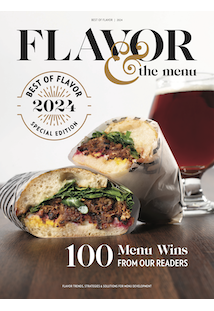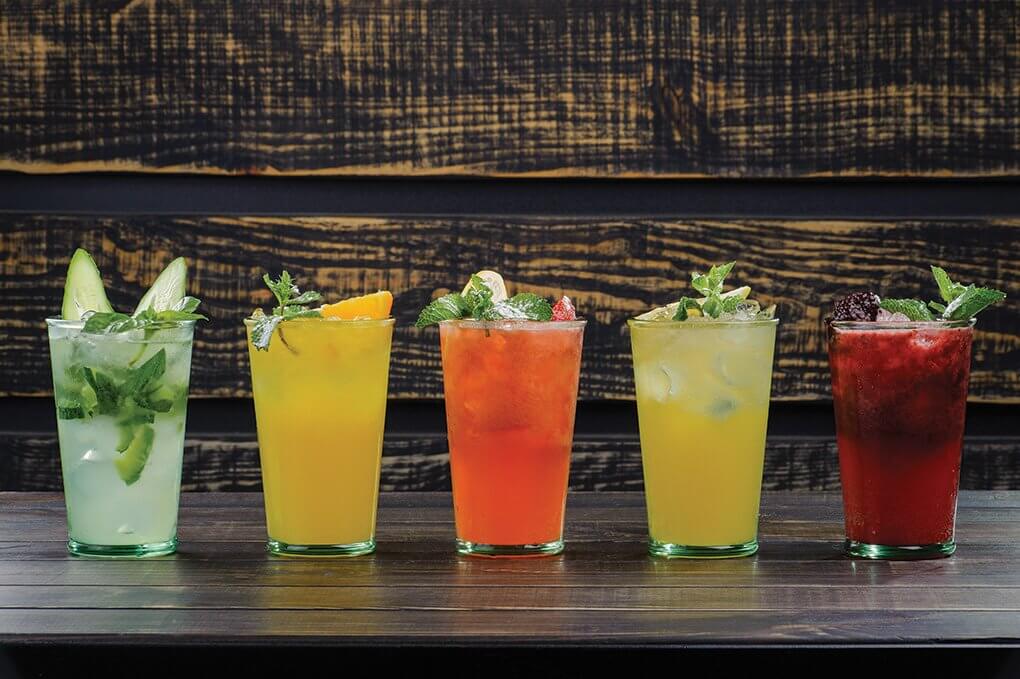Not too long ago, an agua fresca was an obscure offering in the United States, served only at a Mexican bodega or street cart. Meanwhile, raspberry syrup was about as adventurous as flavored lemonade got.
Today, the landscape is vastly different. Fresh, handcrafted and flavorful combinations mark the trend, where lemonades, iced teas, aguas frescas, juices, coffee drinks and specialty sodas are moving in on turf that once was guarded closely by the soda gun.
“As consumers continue to shy away from sugary carbonated soft drinks, they are shifting toward simpler, more natural beverages,” says Amanda Topper, associate director of foodservice research with Mintel. Mintel reports that almost two in five consumers agree that most soft drinks are too high in sugar, and the same percentage wants to see more natural beverages on the menu.
“Specialty iced teas, house lemonades and waters garnished with fresh fruits and vegetables allow operators to put a homemade spin on signature beverages.”
A number of drivers today point toward a widening opportunity in this category. Fast-casual concepts have rung the bell here, making modern non-alcoholic drinks a dedicated, thoughtful part of their menus and signaling a new consumer expectation in the marketplace.
Cava Grill, based in Rockville, Md., with more than 20 locations, offers a seasonal menu of housemade juices and teas, along with all-natural sodas. Recent choices include Blackberry Sage and Cucumber Mint.
At Rotisserie Ema, a fast casual from Lettuce Entertain You Enterprises in Chicago, a number of flavor-forward choices are on offer in bubblers: Ginger Mint Tea, Passionfruit Cucumber Agua Fresca, Blackberry & Sumac Agua Fresca and Chai Tea.

Bubblers are back, signaling freshly made drinks and variety of choice. Rotisserie Ema in Chicago piques diners’ interest with its colorful beverage selection.
Fast casuals are yet again changing the game. By offering handcrafted, flavor-forward, unique drinks, they’re setting expectations. Consumers now look for non-alcoholic choices beyond traditional soda and iced black tea. They want fresh and seasonal. They want interesting choices. They want authentic ingredients.
Fast casuals are also really good at telegraphing those cues of transparency, authenticity and freshness. Perhaps inspired by the fresh and colorful presentation of aguas frescas, bubblers are back, showcasing strawberry flecks in freshly squeezed lemonade, or chunks of watermelon in a summer agua fresca.
Colleges and universities are seizing the opportunity, too, offering modern non-alcoholic beverages, including flavored waters infused with fresh pineapple or thyme or mango, as alternatives to sugary sodas. The dizzying array of options in the retail space has also helped tee up the trend with variety and growing familiarity.
And just as the better burger movement has shifted dining preferences away from cookie-cutter experiences to premium, signature ones, the better beverage movement is shifting preferences and recalibrating expectations. It’s also opening up huge opportunity for menu differentiation.
“Beverages like aguas frescas, lemonades, juices, teas and coffees easily lend themselves to customization, exclusive surprises and seasonal varieties,” says Mindy Armstrong, trends and insights analyst.

GreenRiver in Chicago added a thoughtful selection of non-alc beverages, made with the same attention as its craft cocktails. This Left Hand Wonder stars agave nectar, red beet, ginger, grapefruit and lime.
Complexity of Flavor
The reinvigoration of the non-alcoholic beverage category emulates an overarching movement in foodservice that influences all menu parts: complexity of flavor. “This trend reflects our new way of life now,” says food trends analyst Kara Nielsen. “Consumers are greeted by a huge number of beverage variations in retail and foodservice—ready-to-drink, functional, refreshing, unique. And all promise a signature flavor experience.” Without that, they’d fizzle out, like a flat root beer.
This trend has legs because so many current flavor trends and dining preferences feed into it, making it stronger. The craft cocktail movement, with its attention to detail, freshness and flavor story, has certainly played a part in bringing non-alc innovation to the forefront.
“The rebirth and new interest in non-alcoholic beverages can be credited to their lateral movement into alcohol,” says Suzy Badaracco of Culinary Tides. “That refreshed them—no pun intended—by drawing attention to them, so they had a stronger stance when showcased on their own.”
Mintel’s Topper agrees. “Non-alcoholic beverages can get the same attention to detail and freshness as alcoholic beverages,” she says. According to Mintel Menu Insights, the menu incidence for non-alcoholic beverages increased 20 percent in the last three years.
Carving out opportunity here requires a commitment to flavor innovation. “The possibility is limitless. Initially taking its cues from converting alcoholic beverage to non-alcoholic at its infancy, now as the category matures, anything goes—from global fruit juices to heirloom teas, Meyer lemons to Persian sour lemons,” says Dennis Samala, chef and founder of Creative Culinary Concepts. “Consumer cravings for adventure will continue to drive innovations in this category.”

Places like Anna’s Taqueria, with seven locations in Massachusetts, are introducing consumers to a new world of non-alc, like housemade jamaica and horchata.
Lemonades & Iced Teas
These familiar, well-loved beverages provide a smart platform for creative iterations that express the best of this trend. California Pizza Kitchen was an early adopter on the full-service side, now offering five flavored lemonades and iced teas (original, peach, mango, strawberry and raspberry).
Kali in Los Angeles stands out with a lavender lemonade, while Beatrix in Chicago serves an aronia berry lemonade. Moxie’s Grill & Bar adds fizz to its lemonade, made with fresh-pressed lemons, organic agave and sparkling water.
Seasonality comes through at Champagne French Bakery Cafe, with 10 locations in California. Sparkling Blood Orange Lemonade is its winter offering, with a base of fresh lemonade, a squeeze of fresh California orange and a touch of blood orange syrup.
And Saxon & Parole in New York shows off a refined build in its Spiced Iced Tea: orange pekoe, star anise tincture, mint and lemon.
Tava Kitchen, a fast casual in the San Francisco Bay Area, makes fresh lemonades, smoothies, iced teas and flavored waters an integral part of its mindful menu. The beverages are both bottled in house and showcased in bubblers, successfully relaying freshness cues to its guests. Tava serves three lemonades: Classic, Ginger Lemongrass and Strawberry; a traditional Mango Lassi Smoothie, and a micro-brewed Cardamom Iced Chai.
“First, the colors are beautiful in the display,” says Hasnain Zaidi, Tava Kitchen’s co-founder and COO. “They’re vibrant, fresh and enticing. They also aren’t hyper-sweet. The key is to do them well. They illustrate a commitment to quality and freshness.” The strawberry-flavored lemonade stars organic strawberries and simple syrup. “In the ginger-lemongrass one, guests can see the flecks of ginger. That realness resonates with them,” he says.

Aguas frescas offer an easy pathway to seasonality. Watermelon not only screams summer, but its sweetness cuts down on the need for added sugar.
Juices & Aguas Frescas
Fresh-made juices have always been a premium marker on menus. Today, they also offer a platform for on-trend, produce-centric flavor combinations, like beets, ginger and turmeric. They answer the call for functional food and beverage, promising immunity-boosting, cleansing, energizing and more. Modern juice drinks also entice diners with gorgeous colors and a promise of wholesome transparency.
Mad Greens, a salad concept based in Golden, Colo., menus six freshly pressed juices. Staff members juice out front, inviting the customer to see firsthand the freshness and realness of their product. “It takes a few minutes to make, but they’re willing to wait,” says Dan Long, Mad Greens’ chief culinary officer and co-founder. “It’s visually appealing and helps us demonstrate our brand. They watch the vegetables and fruits go into the blender. They see no additives, no sugars. And it helps build their trust.” Offerings include Beet It (beets, apple, carrots and lime juice) and Wake Up (oranges, ginger root, limes, carrot and apple).
“Fresh juices are an appealing option for consumers looking for a sweet, yet better-for-you alternative to carbonated soft drinks,” says Topper. According to Mintel, more than one-third of consumers want to see more freshly made juices on menus.
The Butcher’s Daughter juice bar in New York and Los Angeles demonstrates its commitment to mindful flavor combinations with its motto: “We treat fruits and vegetables as a butcher would meat.” Stalks & Leaves is a drink there that combines zucchini, celery, spinach, watercress, lemon and dill. It’s available on its own or as part of a juice flight.
TGI Fridays has recently added new handcrafted juices, including the Tickled Pink, with Ruby Red grapefruit juice, guava purée and soda water.
Aguas frescas are refreshing water drinks, often flavored with fruit, like watermelon, honeydew melon, mango and strawberry, and sometimes sweetened with honey or agave. Propelling them into mainstream are a number of drivers—the better beverage boom, the modern Mexican trend, authentic visual cues, and the better-for-you movement.
Mintel reports that menu mentions of aguas frescas have nearly doubled from 2015 to 2016. Rick Bayless’ Frontera Grill in Chicago illustrates the depth of potential creativity here, with offerings like hibiscus tea-lemongrass and yellow watermelon-lemon.
Sweetgreen, a fast-casual salad concept, menus six unique, low-calorie, low-sugar versions of agua fresca. Recent items include a Cucumber-Ginger-Lime Fresca and a Lemon Fresca.

Grapefruit juice serves as a modern base for innovation, here, with a splash of simple syrup and tea for an on-trend take.
Modern Sodas
Handcrafted sodas haven’t replaced the soda fountain, but many operators are choosing to embellish their programs with a few that reflect the brand and showcase a commitment to carefully curated beverages.
Moxie’s Grill & Bar offers a Pomegranate Beet Soda on its Refresh Menu, which also includes coconut water, fresh-squeezed grapefruit juice and GT’s Ginger Kombucha. “I think the days of just having soda fountain offerings are over,” says Kim Spence, Moxie’s beverage director.
“People are more aware of what they are eating and drinking. That being said, sales don’t lie. A significant portion of our non-alcoholic beverages still comes from soda, but the number has been on a steady decline for years. I wanted to reach those early adopters and give them something to rave about.” The Pomegranate Beet Soda combines beets, cucumber, pomegranate molasses and sparkling water.
Beatrix in Chicago serves a refreshing Cucumber & Mint Soda, as well as a Blueberry & Basil Smash.
Multi-unit Bar Louie offers a Watermelon Fizz with watermelon syrup, fresh lime and soda water, and a Mango Limeade soda with mango purée, pineapple and lime juices.
At Juniper in Austin, Texas, seasonal sodas include Blackberry Thyme and Thai Basil Shrub. “We have noticed our guests are invested in knowing where things come from, how they are made, and what’s in them, which extends into our beverage program,” says Nic Yanes, Juniper’s executive chef and owner.

The cold-brew movement resembles the surge of interest and innovation in craft beers. State Street Provisions in Boston offers cold-brew coffee on tap.
Third-Wave Coffee
Coffee culture has never been more dynamic, steeped in micro trends like cold-brew and nitro; there’s always new news to share here. Datassential names a third wave of innovation in this category. Different than specialty beverages like cappuccinos and lattes, this one moves coffee into non-alc beverage development.
Atlanta’s Octane serves the Ameri-Cola, made with a double shot of espresso, Mexican Coke and vanilla syrup. Spitfire in New Orleans menus the Mole Cortado, made with espresso, milk, cane syrup and mole bitters.
“Third-wave coffee has caught on in a fashion similar to craft beer and the craft cocktail movement,” says Brian Darr, managing director of publications at Datassential. He says these drinks, at the inception stage of the trend cycle, are made using a variety of bases: usually cold-brew coffee, espresso, pour-over coffee, or cascara tea, made from dried, unroasted coffee cherries.
Chef-consultant Jorge Cespedes sees big opportunity in coffee beverages. In fact, they are among the biggest sellers with one coffee concept he works with, Cherry Picker Package & Fare in Springfield, Mo. “Some of our best-selling coffee beverages are versions of coffee mocktails,” he says. “For the Apollo, we use a bright and strong espresso and pair it with ginger beer, simple syrup, nutmeg and a lime wedge. Customers love it!”
The non-alcoholic beverage category is bubbling over with opportunity. “There’s profit to be had here,” says Kara Nielsen. “Even if you only add one or two, make it special. When you put so much care into the food, consider the beverage that’s going to go with that food.”










